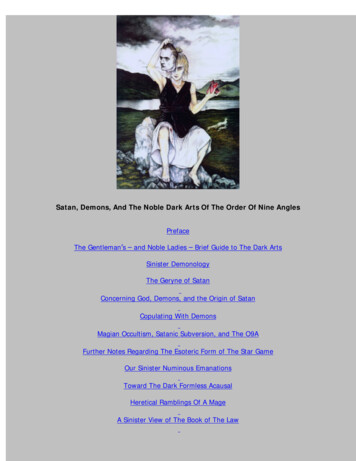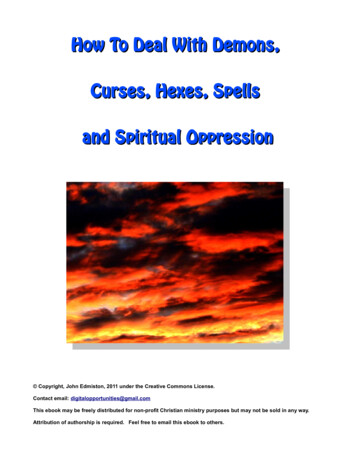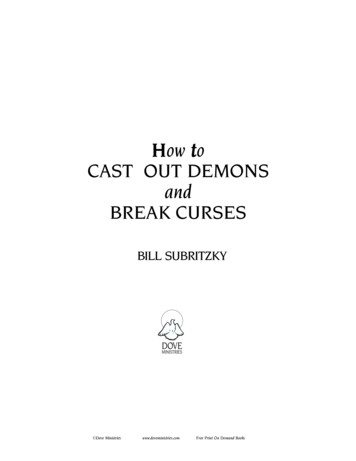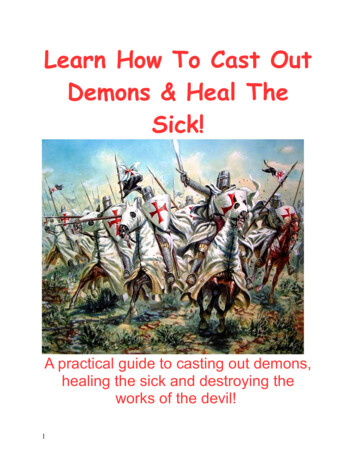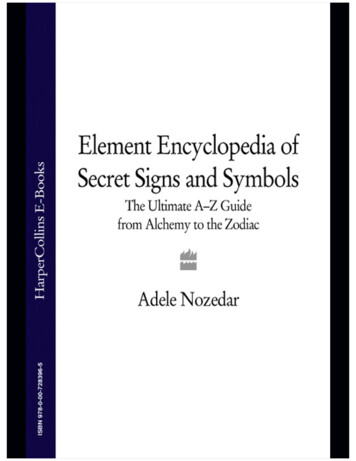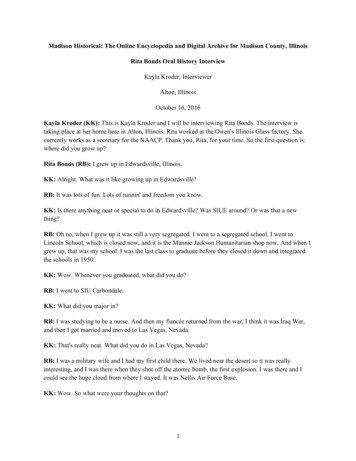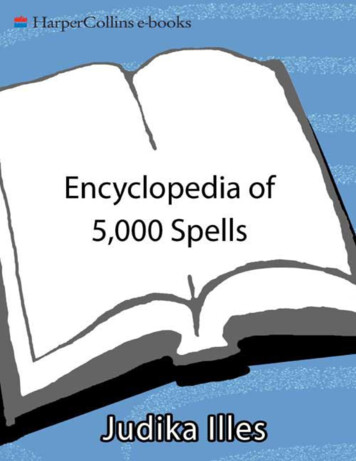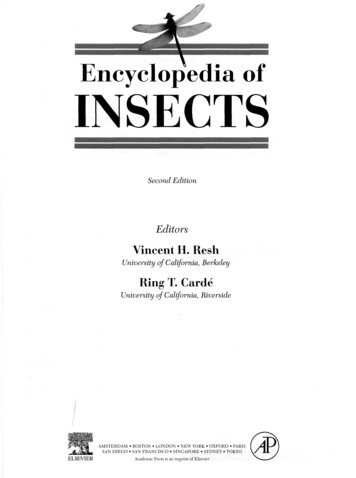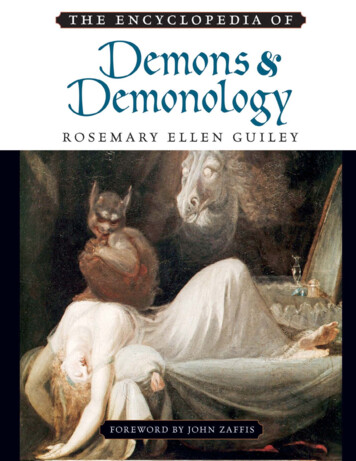
Transcription
Demons andDemonologySSTHE ENCYCLOPEDIA OF
Also by Rosemary Ellen GuileyThe Encyclopedia of Angels, Second EditionThe Encyclopedia of Ghosts and Spirits, Third EditionThe Encyclopedia of Magic and AlchemyThe Encyclopedia of SaintsThe Encyclopedia of Vampires, Werewolves,and Other MonstersThe Encyclopedia of Witches, Witchcraftand Wicca, Third Edition
Demons andDemonologyRosemary Ellen GuileyFOREWORD BY JOHN ZAFFISSSTHE ENCYCLOPEDIA OF
The Encyclopedia of Demons and DemonologyCopyright 2009 by Visionary Living, Inc.All rights reserved. No part of this book may be reproduced or utilized in any form or by any means,electronic or mechanical, including photocopying, recording, or by any information storage orretrieval systems, without permission in writing from the publisher. For information contact:Facts On File, Inc.An imprint of Infobase Publishing, Inc.132 West 31st StreetNew York NY 10001Library of Congress Cataloging-in-Publication DataGuiley, Rosemary.The encyclopedia of demons and demonology / Rosemary Ellen Guiley ; foreword by John Zaffis.p. cm.Includes bibliographical references and index.ISBN-13: 978-0-8160-7314-6 (hardcover : alk. paper)ISBN-10: 0-8160-7314-7 (hardcover : alk. paper)1. Demonology—Encyclopedias. I. Title.BF1503.G85 2009133.4'203—dc222008052488Facts On File books are available at special discounts when purchased in bulk quantities forbusinesses, associations, institutions, or sales promotions. Please call our Special Sales Department inNew York at (212) 967-8800 or (800) 322-8755.You can find Facts On File on the World Wide Web at http://www.factsonfile.comText design by Cathy RinconCover design by Takeshi TakahashiPrinted in the United States of AmericaVB Hermitage 10 9 8 7 6 5 4 3 2 1This book is printed on acid-free paper and contains 30 percent postconsumer recycled content.
SFor John Zaffis
FOREWORDixACKNOWLEDGMENTSINTRODUCTIONENTRIES A–ZBIBLIOGRAPHYINDEX284xiii1280xiSSCONTENTS
SSFOREWORDhad to have a base in all of those in order to be properlyprepared.I learned a great deal from my uncle and aunt andeventually went out on my own. I have been privileged towork with some of the best names in the field, both laypersons, like me, and clergy. I have worked on more than7,000 cases: Many of them have had natural explanations(that is, not paranormal or demonic), and many othershave been resolved with intervention. A few of them havebeen full-blown demonic infestations and possessions. Ido not perform exorcisms—that is a role for clergy—butI have assisted at dozens of these rites.One of the demonic cases brought me face to face withgenuine evil: a reptile-like entity that manifested in aninfested home, a former funeral parlor in Southington,Connecticut, and came at me down a staircase. The intensity of the evil was astonishing. I had never before experienced anything like it, and I have to admit, I was soshaken that it was several days before I could return tothe case. I know from my own experience on this caseand others that evil is real, the demonic exists, and darkforces are at work in the world.As Rosemary Ellen Guiley states in her introductionto this book, the demonic—always fascinating—has acquired a media glamour that has encouraged people towant to become involved as “demonologists.” Many ofthem jump in not properly prepared, not having muchunderstanding of what they are dealing with or the ramifications and consequences of this kind of work. Thework is never easy, and there is the constant danger ofI have spent more than 30 years dealing with the shadowside of the paranormal, including negative hauntings anddemonic cases. I never actually intended to become sodeeply involved, but as most of us in this field are, I wasdrawn in and called to it.The first sign of calling came in my teens. I was about15 years old when I awoke one night and saw my first apparition, my deceased grandfather standing at the foot ofmy bed. Actually, I did not know him; he had died whenI was three years old. But my mother verified my description of him.Perhaps you could say my calling was “in the blood,”as my mother was a twin, and twins have been knownto be more psychically sensitive than the average person.Plus, I was related by blood to one of the most prominentinvestigators of the demonic: Ed Warren, my mother’stwin brother and my uncle. Ed and his wife, LorraineWarren, a clairvoyant, became household names in theparanormal and were in media headlines on some of themost famous modern cases on record. Ed has passed onnow, and Lorraine still works in the field.As a kid I was always fascinated by the work Ed andLorraine did in the paranormal. I wanted to be part ofit too. But Ed was a stickler for the proper education.He refused to allow me to go along on cases before Iturned 18, and he spent a lot of time transmitting hisknowledge to me. I was impatient back then, but Ed, inhis wisdom, knew what he was doing. Dealing with theparanormal, especially the dark side, is not child’s playand requires grounding, education, and discernment. Iix
xThe Encyclopedia of Demons and Demonologyrepercussions. The forces of evil know who you are andwill try to prevent you from interfering in their activities. You, your home, your family, and your friends allbecome targets.I mentioned earlier the importance of education, howEd did his best to make sure I was armed with information, knowledge, and insight in addition to experience. IfI had had a book like The Encyclopedia of Demons and Demonology when I was getting started, I guarantee you thatit would have been well thumbed in a hurry. RosemaryEllen Guiley has gained a well-earned reputation in theparanormal for her thorough research and investigation.I have all of her encyclopedias, refer to them frequently,and recommend them to others. I welcome the additionof this one to my set, and I can tell you that it will be oneof my most valuable resources.I met Rosemary several years ago at a conference inNew Jersey hosted by L’Aura Hladik, founder of the NewJersey Ghost Hunters Society. I was already quite familiarwith her work. We became good friends and colleagues,assisting each other in our work in whatever ways possible and collaborating on projects. We sometimes havedifferent viewpoints, which add dimension to the overallpicture.Beyond paranormal investigation, there is a need forthe average person to become more informed about thedemonic. As a whole we are undereducated on the topic.Many of us get our ideas from Hollywood, maybe combined with a few religious teachings. Rosemary pointsout that many people ignore the topic altogether, hoping that the demonic will just “go away.” I assure you,the forces of evil have no intention of disappearing. Infact, we in the field are seeing an increase in intensityand frequency of activity. That is why education is soimportant. The Encyclopedia of Demons and Demonologycovers an amazing amount of material and from different perspectives. That is one of the many things I appreciate so much about Rosemary’s work: She looks ateverything from different angles. Whether you are serious about paranormal investigation or are a casual readerintrigued by a fascinating subject, this book will broadenyour knowledge. Everyone who picks up this book willlearn something new.—John Zaffis
SI am deeply indebted to John Zaffi s and Adam Blai, whohave shared their knowledge and expertise on demonsand demonology with me. I am also indebted to PhilipJ. Imbrogno, for sharing his expertise on djinn. ThanksSACKNOWLEDGMENTSalso go to the very talented Richard Cook and ScottBrents for creating some original artwork in this bookand especially for putting faces on some most unusualdemons.xi
SSINTRODUCTIONness. Our fate in the afterlife—eternal heaven or eternalhell—hangs in the balance.In Christianity, Satan, the Devil, is the thoroughly evilcounterpart to the all-good God. Concepts of the Devildeveloped over centuries, evolving from the neutral adversary, satan, of Hebrew lore, and the once-good angelLucifer, who chose pride and fell from grace. Every armyneeds a wholly evil enemy, and Satan obliges Christianityin that sense.Demons, the lower agents of evil, have many guisesand operate under many names and with many purposes.In the pagan view, they are a part of the natural order,entities of moral ambivalence who mostly deceive and interfere. In the Christian view, they are evil—fallen angelswho, as Lucifer did, chose pride over obedience to Godand were cast out of heaven. They are doomed to eternalhell and serve the Devil, making unending assaults onhuman beings in an attempt to subvert souls to the Devil’sdomain.Outside monotheism, demons have a long history ofinterfering in the affairs of the physical world and the livesof people, though not always with the goal of subvertingsouls. They act as tricksters and create annoying disturbances. More seriously, they cause illnesses, insanity, disasters, and bad luck. Some hold long-standing grudgesagainst humanity. The djinn of Arabian lore, for example,say they were the original inhabitants of Earth and wereevicted by God in favor of humans. They want their homeland returned, and some of them carry out guerrilla warfare and terrorism against humans to that end.Dealing with evil has occupied center stage in human affairs since our earliest times. Destruction, chaos, decay,and the ultimate darkness of death have often overshadowed the presence of goodness and light. Human beingshave dealt with evil in three principal ways: by meeting ithead on in battle, by warding it off before it strikes, andby trying to avoid it altogether through denial.The how and why of evil have been debated and discussed for centuries in religion, folklore, philosophy, art,literature, and pop culture, all of which attempt to explainwhy bad things happen, especially to good people. Whenevil strikes the wicked, we see it as the deserved consequence of evildoing. When evil strikes the righteous, welook for satisfactory explanations, often in vain. Everyonefeels the touch of evil at some point in life, regardless ofhis or her moral striving.In myth, religion, and folklore the forces of both goodand evil are personified. In the pantheons of deities thereare gods and goddesses of benevolence and malevolence,and though some are mostly evil, they are seldom completely evil. Their job is to tear things down via disaster,ruination, disease, illness, and death. They are an essential part of the eternal cycle of life, death, and rebirth. Human beings, understandably, seek to avoid these tormentsas much as possible.Monotheism creates a sharper polarization betweengood and evil. The one Creator is all-good but permitsevil to exist under the direction of an archfiend. We console ourselves with the explanation that evil serves to testand demonstrate our moral fiber and spiritual worthixiii
xivThe Encyclopedia of Demons and DemonologyWhatever the guises, names, and agendas, demonicforces are constantly at play in the world. Thanks to theexaggerations of film and fiction, many Christians think,for example, that demonic attacks occur in the form ofhideous beings assaulting people, possessing them, andmaking green slime run down walls and stairs. Whilesuch events do happen, they are relatively rare among allthe ways the demonic forces operate. Evil is insidious, aTrojan horse that destroys from within, degrading people’s thoughts, intentions, and will to lead the righteouslife. Evil often operates through people, in the murder,mayhem, oppression, and violence people wreak on oneanother.Several years ago, in my introduction to my Encyclopedia of Angels, I affirmed my belief in angels. I also believein demons. One does not exist without the other. I havehad personal experience of both. In my years of researching the paranormal, I have been puzzled by people whoadamantly insist that demons do not exist. They readilybelieve in angels and other representatives of the forcesof light and good, but they deny malevolent beings. Theywould rather not know anything about the demonic in order not to “dignify” it. Some of them naively think that ifthey do not believe in demons, they will not be botheredby them. “See no evil” means to them “avoiding all evil.”Ignorance is their protection.Ignorance, however, is no protection. Ignorance breedsfear, and fear is evil’s greatest weapon. One of the things Ihave found to be true in my paranormal research, investigation, and personal experience is that what you fear willfind you. Demons are the front lines of evil. Denying theirexistence only makes human beings easier targets.Consequently, it is important to be informed aboutdemons and evil. One conquers an enemy by knowing itinside and out. To know evil does not mean to embrace it,champion it, or glorify it.Information shines a powerful light, and it is important that we shine that light into the darkness. Mypurpose in writing this encyclopedia is to provide oneof those lights. The content is not intended to validateany particular religious view. Rather, I have explorednumerous avenues of thought on the demonic. Thereis much diversity but also some common threads andthemes. Some common themes, for example, concernthe origins and fate of evil. The world in its originalstate was pristine, perfect, and good. The forces of evilentered the world, often through the actions of humans.Since then, the forces of evil have been having their day,wreaking havoc. At some point, good will vanquish evil,and perfection will be restored. Meanwhile, there aremany ways to counter evil, to minimize its impact inthe world.The lore about demons is rich and varied, and thestories of human dealings with demons are colorful andmesmerizing. All of my encyclopedias emphasize theWestern tradition, with the inclusion of some cross-cultural entries for comparison. In this volume, I haveincluded entries on many individual demons, includingthe heavyweights of hell; types and classes o
1. Demonology—Encyclopedias. I. Title. BF1503.G85 2009 133.4'203—dc22 2008052488 Facts On File books are available at special discounts when purchased in bulk quantities for businesses, associations, institutions, or sales promotions. Please call our Special Sales Department in New York at (212) 967-8800 or (800) 322-8755.

